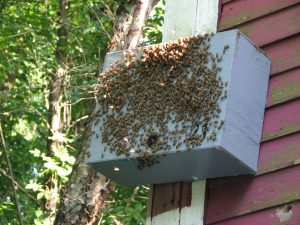 It’s springtime and a lot of folks are eager to expand their apiary by doing splits. Splits are very popular since they are “almost free”. Problem is, a good portion of those doing splits use the “walk away” method, because it’s easy and cheap, without thinking it through.
It’s springtime and a lot of folks are eager to expand their apiary by doing splits. Splits are very popular since they are “almost free”. Problem is, a good portion of those doing splits use the “walk away” method, because it’s easy and cheap, without thinking it through.
Bees will rear queens in three different circumstances. Swarm queens, supersedure queens, and emergency queens. Swarm queens are reared when a colony is booming, resources are plentiful, and the colony is ready to initiate a natural split. Swarm queens are reared out of desire and not out of need, and are also reared vertically in queen cups. Since swarm queens are initiated by bee when conditions are optimal, the results are quality queens.
Supersedure queens are reared when the colony is unhappy with the performance of the queen and decide to replace her. Supersedure does not consider availability of resource or drone population for proper mating. Supersedure queens are reared from eggs of an unacceptable and/or failing queen, therefore results are marginal at best. You will find some folks that say supersedure queen are perfectly fine. Just keep in mind, that although young supersedure queen may seem just fine, come fall, when the weather starts getting tougher is when the poor quality is most likely to show up. This also, coincidentally, is the worst time to have to try and requeen. I have also seen, and heard from many beekeepers, of hives that will perpetually supersede the queen. This leads me to believe that whatever quality of the queen the bees do not like is being passed through genetics.
Emergency queens are the worst case for the bees. They have no laying queen and the colony will perish if the situation is not rectified. There is no current queen so one is raised from eggs laid in worker cells. What differentiates a queen from a worker is the food that is fed to the larvae on or around day 3. This happens to coincide with the bees needing to get the larvae from the horizontal cell to the new vertical cell they build on the face of the comb. To get the larvae to the correct position, they float it out on thinned out royal jelly. Does this thinned out royal jelly have the same nutritional value? Right at the critical time of a larvae being either a worker or a queen. There may not be an abundance of resources for the bees to produce quality royal jelly and they just do the best they can. Out of necessity, they will attempt to raise multiple emergency queen in hope that one is successful. Any larvae that may be a little older (more than 3 days and didn’t continue to get feed straight royal jelly) will also be the first to hatch and kill all the younger, perhaps better quality, unhatched queens. I also often hear that bees will know and always select the right aged larvae. Out of desperation, bees will try and rear a queen from a non-fertile laying worker larvae (drone), so wouldn’t it be plausible they would attempt to rear from a slightly older than prime larvae? Are “good enough” queens OK, or do you want the best queens?
So next time you plan to do a split, either wait until you have some nice swarm cells, rear yourself some quality queens, or truly think through the long term costs before you write off a $20 quality queen as too expensive. Any beekeeper trying to deal with a late Fall/Winter queen failure would gladly drop $20 if given the chance for a do-over.

![Not All Flowers Are Friendly: Honeybee vs. Milkweed [Must-See Video]](https://beevac.com/wp-content/uploads/2025/06/milkweed-blooms-1340941-400x250.jpg)


Can you trigger them to generate swarm cells by crowding the colony, and then once a cell appears head off the swarm by splitting the old queen into a nuc? On the theory that the main colony won’t swarm because it has no queen, and the queen nuc wont swarm because it has no work force. Why is that a bad idea (if it is)?
Or how about putting the queen from a strong colony into a nuke and then breaking out the bottoms of the cells on some young (less than 36 hours old) brood to help encourage them not to make a queen out of older larvae. As outlined here – http://mdasplitter.com/ I’m sure you have an opinion about that.
It isn’t so much the $20 for a new queen as it is a desire to try for survivor genetics from a local drone – I know it also might be from a neighboring beek as well, but if you don’t try…
Can you trigger them to generate swarm cells by crowding the colony, and then once a cell appears head off the swarm by splitting the old queen into a nuc? On the theory that the main colony won’t swarm because it has no queen, and the queen nuc wont swarm because it has no work force. Why is that a bad idea (if it is)?
Sure you can, and it is a much better option than a walk away split. The drawn back is that you are doing perhaps just as much manipulation of the hive and getting fewer or joined swarm cells, have to handle them and potentially crush damage then the cut them out. Why not just use the effort and resource to rear queens?
Or how about putting the queen from a strong colony into a nuke and then breaking out the bottoms of the cells on some young (less than 36 hours old) brood to help encourage them not to make a queen out of older larvae.
I’m not completely familiar withe the method, but believe it still requires them to float the larvae out to a vertical cell, I think the Hopkins or Miller method would be better.
It isn’t so much the $20 for a new queen as it is a desire to try for survivor genetics from a local drone – I know it also might be from a neighboring beek as well, but if you don’t try…
People often confuse my concern with supersedure/emergency cells as an issue with raising your own queens, when my position is quite the contrary. I am a firm proponent of acclimatized and feral bees and would strongly encourage everyone to raise their own queens. Just be sure to use a method of queen rearing that optimizes the chances of good quality queens.
Thanks for the helpful reply. Of course I’m new to bee keeping, and only have one (new) hive this year, so I want to plan my next move before I have a rush situation. I think that queen raising is something that I will want to do in the future, but my first concern is to turn my one hive into two so that I’m only half as likely to suffer a total loss. So, for now (or soon I hope) I just need 1 new queen. Is there any reason that when you trigger swarming by crowding that you would have to cut out the cells? Can’t you just let it alone and let the strong survive?
Also, if you don’t mind – when swarm cells are built how long do you have to get the old queen out to prevent an actual swarm? Will once a week inspections insure that you won’t just miss it? Being new I already have to restrain myself to keep from constantly pestering them. I’ll get over it with time.
Again thanks – great site. You’re a good communicator.
Is there any reason that when you trigger swarming by crowding that you would have to cut out the cells? Can’t you just let it alone and let the strong survive?
The only reason to cut them out is if you want more than one queen to survive. You can just leave them and let the first to hatch survive, this is exactly what happens with ferals. The draw back is you are not taking full advantage of all the resources used to create the multiple cells. But in your case of only wanting one queen, it meets your need, just not the most efficient.
when swarm cells are built how long do you have to get the old queen out to prevent an actual swarm? Will once a week inspections insure that you won’t just miss it?
As I’m sure you have already learned, nothing is definite when dealing with bees, but normally the swarm won’t leave until the queen cells are capped, so a weekly check should give you a good chance. Once a hive gets the swarming impulse, it can be difficult to get them out of swarming mode. If you go this route, I would suggest a shook swarm as used in making comb honey to break the swarming impulse. Basically you remove your queen and shake 2/3rds of the bees into a new hive of foundation. The lack of brood simulates that they have swarmed. Good Luck
rob….
When crowding and then removing the swarm cells you have caused, you better make sure you get them all or the will still swarm. If you remove the queen they will still build swarm cells and then wait for one to hatch and swarm anyway.Good Luck and GOD BLESS,Lyle